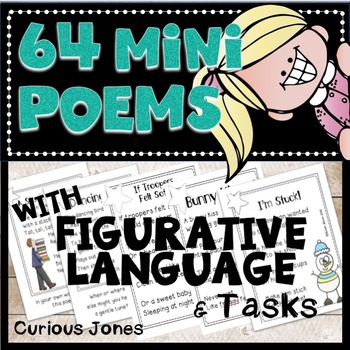Poetry With Figurative Language & Devices - 64 Mini-Poems & Response Tasks
- PDF
What educators are saying
Also included in
- This bundle includes 4 products. Please see the following links to understand everything that is included.Price $10.00Original Price $14.00Save $4.00
Description
These 64 quirky and clever mini poems can be used in so many ways. Whether it's centers, poetry journals, partner activities, an introduction or conclusion to a poetry unit or the day, you will find these very useful and versatile. The poems are written with six main literary devices in mind including:
16 mini poems with personification, rhyme and rhythm.
16 mini poems with repetition
16 mini poems with alliteration
16 mini poems with imagery
Anchor pages with example poems are provided for each literary device.
You are provided with mini-poems with a pre-written task and a copy of the mini poem by itself, just in case you would like to create your own task.
This was created by Gwen Jones aka Curious Jones
CCSS.ELA-Literacy.RL.2.4 Describe how words and phrases (e.g., regular beats, alliteration, rhymes, repeated lines) supply rhythm and meaning in a story, poem, or song.
This is the main standard that can be addressed, however, there are so many more!





